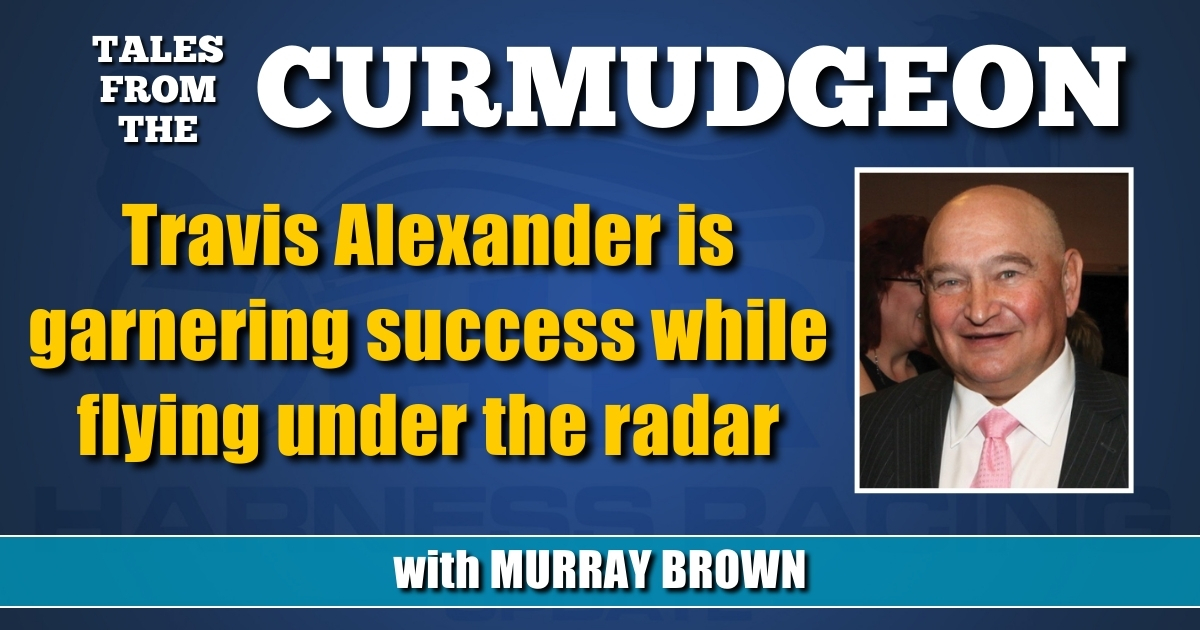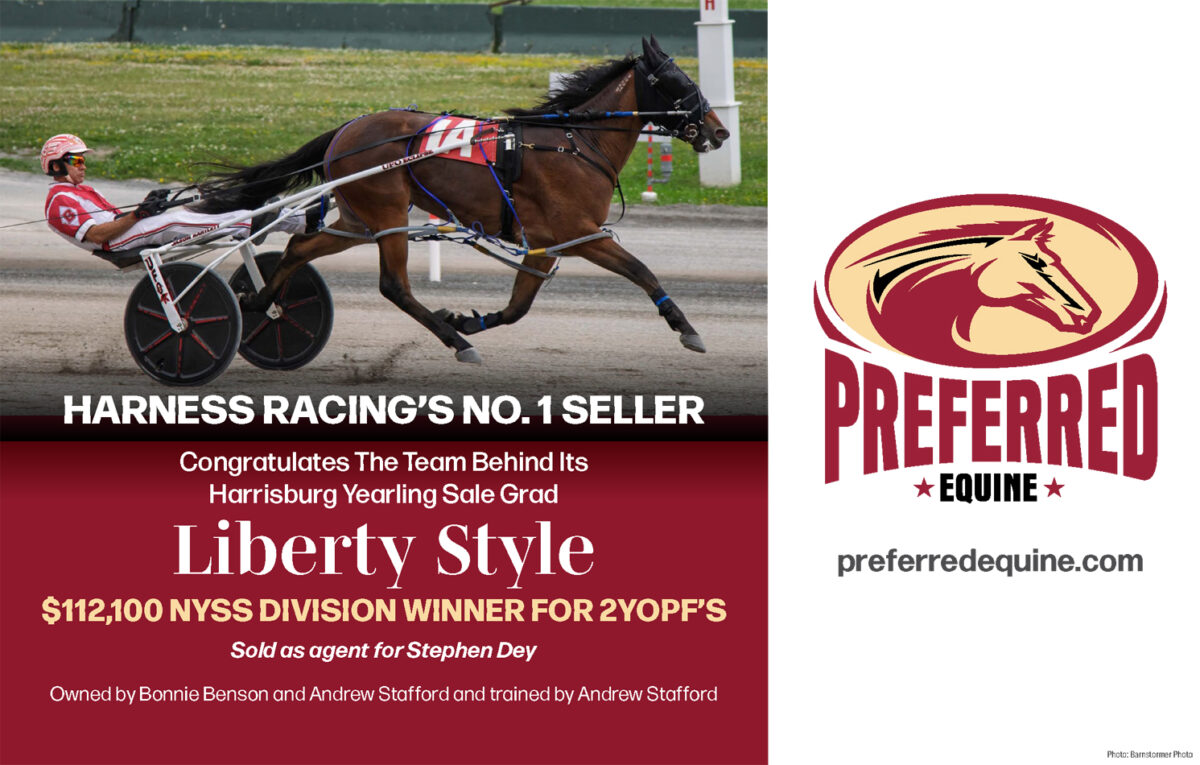Travis Alexander is garnering success while flying under the radar
by Murray Brown
It should not have been, but it was a slight surprise to this observer that the third leading stable in North America in both earnings and wins with $2,376,940 and 144 respectively is that of Michigan native Travis Alexander. This past week Alexander also notched win number 1,000 as a trainer. He is a fifth-generation horseman and the first in his family to leave Michigan. The Alexander Stable is presently domiciled at Mark Ford’s Training Center in Middletown, NY, a 90-minute ship from Yonkers Raceway and two hours from Pocono Downs, the two tracks where its horses are most likely to be racing. It was on a jaunt to Pocono where he was racing two 3-year-olds that this reporter caught up with Alexander.
You represent the third leading stable in North America, both in money earnings and wins. That is quite an accomplishment. Some might say you have perhaps been flying a little below the radar. Do you believe that to be the case and how is your stable made up?
“To some degree that might be so. If indeed that is the case, it may be because a good part of the group is made up of overnight horses. Right now, we have horses that fit just about every class, both trotters and pacers at Yonkers, Pocono Downs and The Meadowlands. The stable is presently composed of 90 head, half of which are 2- and 3-year-olds; 25 of those are 2-year-olds, some of which will be making their first starts [Wednesday (June 19)]. I suppose the flying under the radar mostly relates to the way publicity is attained in the business. Most of it goes to the glamour horses, those that excel on the Grand Circuit.
“Thus far, I would describe our stable as being mostly a meat and potatoes operation. That’s not to say that I am not looking for the great Grand Circuit horse. That is in the background of my mind with every yearling that comes into the stable. But with every youngster we acquire, we primarily want the opportunity to race for decent money. That means, if the horse is not destined to be a Grand Circuit performer, which realistically applies to the vast majority of them, we want one that will acquit itself well in the sire stakes, most specifically those in New York and Pennsylvania, the states to which most of our youngsters are eligible to race. They are close by and they still race for very good money. That is one way in which the great Kentucky money has perhaps indirectly helped New York, New Jersey and Pennsylvania.
“To some extent the competition in those areas has been lessened because so many more of the better horses have found their way to Kentucky. That’s not to say that we will not race in Kentucky if we have a horse which we feel will be competitive there. We have two racing at Oak Grove next week. Those $50,000 races just about every week for 4-year-olds, has been a great boon for horses who are not quite true free-for-allers yet, or those who might never become that. I’m a great believer in racing horses where I believe they can earn money and help the owners.
“I like to think of myself and my operation as being very client oriented. In most, I guess in just about all areas, the owners call the shots if they are so inclined. We do all we can to follow their wishes. If they prefer racing overnight horses, that is what we do. If they want to follow their dreams and race in stakes races we also provide a vehicle for that.”
Let’s talk about your 2-year-old class.
“As I said, some of them will just be beginning to race [Wednesday]. We have five in to start at Pocono Downs. Of those, I am particularly excited about a Cattlewash filly named Eightsevensix. She has probably been our best one all winter and spring. That is not to say that the rest of the class is behind. That is definitely not so. There is just something about this particular filly which I’ve loved from the very get go. In addition to the Cattlewash, we have two Huntsvilles, a Captaintreacherous and a Sweet Lou starting tomorrow. We have several others waiting in the wings who I believe will become really good 2-year-olds, maybe even that rarity, a great star. We are barely into summer, that time of year when we are still dreaming. They are just beginning to sort themselves out.”
Speaking of the Cattlewash filly, it’s still early, but from only a very small crop those 2-year-olds by Cattlewash seem to be making a great impression.
“Yes indeed. From only a small crop of 38, he already has six sub-1:58 winners. Forty per cent of the entire crop has already raced. I thought that two them, Power Code, the colt that Carl Jamieson has and my filly were two of, if not the two most impressive, 2-year-olds in training at Sunshine Meadows this past winter. But as we all know, training well is one thing, racing well can be quite another. There are two things perhaps among others that Cattlewash has in his favor. Firstly, he was a great racehorse, virtually all great sires were. There is the odd exception, but it is exceedingly rare and if it took place, it usually happened a long time ago. Secondly, and maybe just as important, is that he is a great son of Somebeachsomewhere.
“Just look at SBSW’s accomplishments as a sire of sires. He already has Captaintreacherous, Downbytheseaside, Huntsville and Stay Hungry. So Surreal has also done really well from limited opportunity. This year we have Cattlewash and Papi Rob Hanover both looking good from their first crop. Then there is Beach Glass in Ontario waiting in the wings. If there is another horse who has produced as many good sires, I cannot think of who it might be.”
We spoke of your 2-year-olds, how about your sophomore class?
“We have a 3-year-old homebred of Dr John Cummins named Dame Good Time, that I believe will be a pretty good colt, I should say gelding. He has earned almost $200,000 and seems to be continually getting better. I doubt that he is as good or probably will ever be as good as Karl, but he is our best 3-year-old. We are aiming him towards Aug. 3, Hambletonian Day at The Meadowlands. It’s far too much to think that he will or can be a match for Karl and maybe some of the other 3-year-old trotters out there. But it’s horse racing. If nothing else, we are allowed to continue to dream until as sometimes happens our dreams are shattered.”
Let’s speak about Michigan and your roots in Michigan racing.
“As I told you, I am a fifth-generation horseman. None of my ancestors ever left the state to race elsewhere. I was the first to do so. Growing up, there were seven thriving racetracks in Michigan. Now, sadly, none remain. It’s a tale that can be found to varying degrees throughout North America. Montreal was once the leading racing center in all of Canada. Now, sadly, a metropolis of several million people many of which were once great fans of the sport doesn’t even have a single racetrack. Florida racing is dead, likely never to be revived.
“Despite the casinos efforts to make us a dead issue, we still race for decent money in New York and Pennsylvania. But both states have the same problem, nobody goes to the races. Sadly, the same to a lesser degree holds true for our greatest racetrack The Meadowlands.
“There are still reasons for some optimism though. Kentucky, at least the breeding industry in Kentucky, is thriving. The same to a lesser degree holds true for Ohio and Indiana. How do we get new fans to come to the races and watch our great equine athletes compete? I wish I had the answer to that. Unfortunately, I do not. However, unless we come up with a way to generate more interest in the sport, I don’t know how we can continue over the long haul.”
It’s now summer, the time of year when the stable functions mostly as one big, well-oiled machine, but there is a time of year when you have a northern division based in New York and one in Florida at Sunshine Meadows.
“From November through early May we train our young horses in Florida and keep those racing or preparing to race in New York. I think that this is best for the horses, the owners and maybe for the people who look after them, especially the ones who train in Florida. I think it works very well. We have a great staff and have great lines of communication among us. We do have some people who specialize with the younger horses and those who work mostly with the racehorses.
For example, Doug Miller is one of the most important members of the team. He trains with us, specializing with the young horses year-round. Beginning in late summer, he hits the road visiting the various breeding farms evaluating their yearlings. He acts as our scout much as Perry Soderberg and Dr. Bridgette Jablonsky do for their various clients. Doug is an excellent horseman with a wealth of experience. By the time the sales come along we have narrowed our list down to those that we feel we can best concentrate on for our various clients.”
Speaking of your clientele, a stable of 90 head must involve a good many owners. How many owners have horses in the Alexander Stable?
“Presently there are 25. They range from a single owner who might have a percentage of one horse to Mark Wasserman, who’s Fiddlers Creek Stable owns all or parts of quite a few horses in training with us. Mr. Wasserman is more than just an owner of racehorses with the stable though. He has been with us since 2008, pretty much from the time I first went out on my own. We help him not only with the horses he has racing, but also in having put together what I feel is a pretty elite broodmare band. Fiddlers Creek now owns 20 broodmares from which we breed and raise yearlings to eventually join our racing stable. There was a time when Fiddlers Creek had no partners. Mr. Wasserman preferred it that way.
“As I’ve said more than once, we try to be as owner oriented as possible. Whatever an owner desires, we try to accommodate. Today, in addition to its homebreds, Fiddlers Creek often comes aboard in the yearlings we purchase for our other clients. I like to think of our operation as one happy family that continues to both grow and thrive.”

















